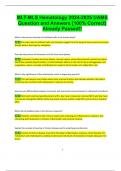MLT-MLS Hematology 2024-2025 UAMS
Question and Answers [100% Correct]
Already Passed!!
What is the primary function of red blood cells in the human body?
The main role of red blood cells is to transport oxygen from the lungs to tissues and carry carbon
dioxide back to the lungs for exhalation.
Describe the process of hemostasis and its three main phases.
Hemostasis involves three key phases: vascular spasm, where blood vessels constrict to reduce
blood flow; platelet plug formation, in which platelets adhere to the site of injury and aggregate; and
coagulation, where a cascade of clotting factors leads to the formation of a stable fibrin clot.
What is the significance of the reticulocyte count in diagnosing anemia?
The reticulocyte count helps assess bone marrow function and indicates whether the body is
producing new red blood cells adequately in response to anemia.
How can you differentiate between microcytic and macrocytic anemias based on red blood cell indices?
Microcytic anemias typically present with a low mean corpuscular volume (MCV) and low mean
corpuscular hemoglobin (MCH), while macrocytic anemias exhibit a high MCV and normal or elevated
MCH.
What role do platelets play in the immune response?
Platelets contribute to the immune response by releasing pro-inflammatory mediators and
interacting with leukocytes to enhance inflammation and promote healing.
Explain the concept of anemia of chronic disease and its underlying mechanisms.
Anemia of chronic disease arises from the body's inflammatory response, which disrupts iron
metabolism and erythropoiesis, leading to decreased red blood cell production despite adequate iron
stores.
1
,How does the structure of hemoglobin affect its function in oxygen transport?
Hemoglobin's quaternary structure allows for cooperative binding, meaning that the binding of
oxygen to one heme group increases the likelihood of other heme groups binding oxygen, optimizing
oxygen transport and release.
What is the difference between intrinsic and extrinsic pathways of coagulation?
The intrinsic pathway is activated by damage to the blood vessel wall and involves factors present
in the blood, while the extrinsic pathway is initiated by external trauma and requires tissue factor from
damaged tissues.
What are the clinical implications of thrombocytopenia?
Thrombocytopenia can lead to increased risk of bleeding and bruising, and it may be caused by
various conditions such as bone marrow disorders, autoimmune diseases, or certain medications.
Discuss the significance of performing a peripheral blood smear.
A peripheral blood smear allows for the microscopic examination of blood cells, aiding in the
diagnosis of various hematological disorders by assessing cell morphology, distribution, and overall blood
cell health.
What laboratory tests are commonly used to evaluate iron deficiency anemia?
Common tests include serum ferritin, serum iron, total iron-binding capacity (TIBC), and
transferrin saturation, which together provide a comprehensive view of iron status in the body.
Describe the characteristics and causes of sickle cell anemia.
Sickle cell anemia is characterized by the presence of sickle-shaped red blood cells, leading to
vaso-occlusive crises and hemolysis. It is caused by a mutation in the β-globin gene that results in
abnormal hemoglobin (HbS).
What are the potential complications of polycythemia vera?
Complications of polycythemia vera include thrombosis, hemorrhage, and transformation to
myelofibrosis or acute myeloid leukemia due to excessive red blood cell production and blood viscosity.
2
, How does vitamin B12 deficiency lead to neurological symptoms?
Vitamin B12 deficiency can result in demyelination of the spinal cord and peripheral nerves due
to its role in myelin synthesis, leading to neurological symptoms such as numbness, tingling, and
cognitive changes.
What is the purpose of performing a Coombs test in hematology?
The Coombs test is used to detect antibodies against red blood cells, helping to diagnose
conditions such as hemolytic anemia, autoimmune disorders, and transfusion reactions.
Explain the role of erythropoietin in red blood cell production.
Erythropoietin is a hormone produced by the kidneys in response to low oxygen levels,
stimulating the bone marrow to increase red blood cell production to enhance oxygen delivery to
tissues.
What are the distinguishing features of hemolytic anemias?
Hemolytic anemias are characterized by the premature destruction of red blood cells, leading to
symptoms such as jaundice, dark urine, and splenomegaly, with increased reticulocyte counts as the
marrow attempts to compensate.
How do anticoagulants function to prevent thrombosis?
Anticoagulants inhibit various steps in the coagulation cascade, thereby reducing the formation
of fibrin clots and preventing thrombus development in blood vessels.
What is the significance of lactate dehydrogenase (LDH) levels in hemolytic conditions?
Elevated LDH levels indicate tissue damage and increased cell turnover, often seen in hemolytic
conditions, as LDH is released from lysed red blood cells.
Describe the impact of chronic kidney disease on hematological parameters.
Chronic kidney disease often leads to anemia due to decreased erythropoietin production and
impaired iron metabolism, resulting in lower red blood cell counts and altered iron indices.
What are the common causes of leukocytosis?
3




